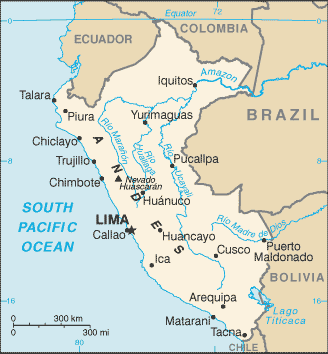 Peru's National Police on Feb. 4 announced the discovery of over 100,000 cannabis plants at the high Andean community of Minasel, 4,000 meters above sea level, on the border of Áncash and Huánuco regions. The plants were burned in the fields, polce said, while the growers escaped into the mountains. (RPP, Feb. 4) On Jan. 15, elite troops of the Special Anti-drug Operation Division eradicated 65,000 plants of moño rojo (red bud) at the remote mountain village of San Martín de Porres, Chinchao district, Huánuco. (Peru21, Jan. 15)
Peru's National Police on Feb. 4 announced the discovery of over 100,000 cannabis plants at the high Andean community of Minasel, 4,000 meters above sea level, on the border of Áncash and Huánuco regions. The plants were burned in the fields, polce said, while the growers escaped into the mountains. (RPP, Feb. 4) On Jan. 15, elite troops of the Special Anti-drug Operation Division eradicated 65,000 plants of moño rojo (red bud) at the remote mountain village of San Martín de Porres, Chinchao district, Huánuco. (Peru21, Jan. 15)
Cannabis claims a growing share of Peru's US-mandated eradication effort. In 2013, Peru's authorities eradicated more than 23,947 hectares of coca leaf, up significantly from the 14,234 hectares destroyed in 2012. And the National Police Anti-Drug Directorate (DIRANDRO) expects the figure to rise in 2014, having beefed up troop stregnth and planning unprecedented simultaneous operations acorss Peru's 13 identified coca-growing zones. Peru has 60,400 hectares under cultivation, according to the 2012 report of the UN Office on Drugs and Crime (UNODC). The figure represents a 3.4% decrease from 2011. The figures for 2013 are to be released in September.
A total of 93% of all coca crops is for the illegal trade, with just 7% used for traditional consumption for the legal internal market, according to Carmen Masías, the executive president of the National Commission for a Drug-Free Life (DEVIDA), Peru's equivalent of the drug czar. Masías boasted that, unlike in Colombia, no pesticides are used in the eradication. "We respect the environment, even if it means that our objectives take slightly more time to be achieved," she said.
In 2013, more than 28 metric tons of drugs were seized in Peru, including 10.8 metric tons of cocaine paste, 13.3 metric tons of cocaine hydrochloride, 3.7 metric tons of cannabis and 0.6 metric tons of opium. All of these figures are up from 2012—and the share of cannabis in total seizures also jumped. In 2012, a total of 24.7 metric tons of drugs were seized, including 2.4 metric tons of cannabis. (InfoSurHoy, Feb. 5)
Peru's cannabis production zones sometimes overlap with the the coca-growing zones, in the high jungle where the Andes slope down towards the Amazon basin—particularly the Upper Huallaga Valley. But the resilient and adaptable cannabis plant is also grown in the inter-Andean valleys of Áncash and other coastal regions, which snake down from the mountains to the Pacific. So an aggressive anti-cannabis campaign could spread the militarization and corresponding unrest from the coca zones to much of the rest of Peru's Andean ranges. This despite the fact that Peru is not a major exporter; the cannabis (unlike the coca) is being grown almost exclusively for the internal market. Let's hope dissident voices in Peru can raise the Uruguayan example as an alternative model.
Cross-post to High Times
Graphic: US State Department







Recent comments
15 weeks 5 days ago
19 weeks 6 days ago
21 weeks 3 days ago
21 weeks 4 days ago
33 weeks 6 days ago
39 weeks 4 days ago
50 weeks 4 days ago
51 weeks 3 days ago
1 year 6 days ago
1 year 1 week ago